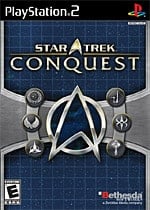Mediocrity Is Futile
Even the most diehard Trekkie isn’t going to automatically drink poison Kool-Aid just because it’s served in a Star Trek themed Dixie cup. Along similar lines, haphazardly slapping some Next Generation era visuals and a few novelty sound effects on a bare-bones game engine isn’t going to be very palatable to the masses of Star Trek fans that’ve been anxious to get their Trek on. There is a certain level of guilty pleasure to be found in Conquest. Unfortunately, the blasphemous disregard for the source material and a lack of features makes it a poor choice for fans of the series.
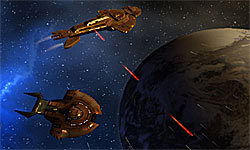
One of the biggest deficiencies becomes evident immediately from the onset of the game. The opening screen provides Conquest’s paper thin setup; it’s more than likely to irk the über faithful. A mere paragraph is practically the only smidgeon of story in the entire game. To make matters worse…it’s complete garbage. The scenario opens amidst a time of war with the six major races – Federation, Klingon, Romulan, Cardassian, Dominion, and Breen – all suddenly gunning to wipe one another off the face of the galaxy. Diplomacy and borderland agreements have been thrown out in favor of a free-for-all quest for supreme domination of all territories. The whole concept just doesn’t jive with the elaborate nature of Star Trek lore, particularly in the case of the Federation who seem to have completely abandoned their prime directive. The offense might have been more forgivable had the developers integrated an actual plot into the main portion of the game.
An extremely inadequate story can be crippling in a Star Trek title, but the gameplay in Conquest does manage to ease some of the pain to a certain point. Campaign mode pits any of the six races against one another in a strategic turn-based battle which revolves around gathering resources, constructing outposts and fleets of warships, and methodically wrenching control of the galaxy away from foes system-by-system. Players can select their home world race, the number and type of opponents, and tweak other gameplay details before launching into a campaign. From there, you’ll be dumped in your small corner of the drab, 2D galactic plane and left to your own devices.
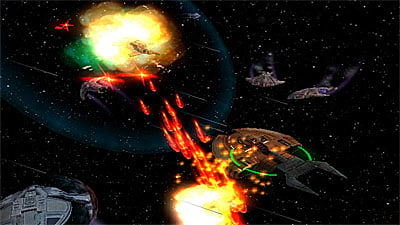
Every race can have up to three admirals and their accompanying starship fleets on the board at any given time. Admirals can gain experience through combat, earn promotions, and also provide their fleet with a bonus either to attack, defense, or movement. New ships can be constructed at any of your star bases, and fallen admirals can be re-recruited at your home world base. You’ll essentially have three options in terms of what units you can build: the weak-but-speedy scout ship, a medium-strength cruiser, and the slow and destructive dreadnaught. Initially, stocking your fleet with a mixture of cheaper and medium class ships allows you to venture forth in the galaxy quickly and snag systems in order to gather resources more quickly. Gaining control of a system allows you to construct mines to accrue resources, star bases to purchase units, science facilities to research super weapons (the Genesis Device is particularly cool), and defense turrets to protect your investments.
On the galaxy field, the different factions will take turns moving their admirals, but things heat up when you encounter an enemy fleet or a band of roaming space brigands (the Ferengi and the Borg make brief guest appearances in the form of random encounters in unoccupied systems). Combat in Conquest offers players a few interesting options. If you just want to get the battle over with quickly, you can elect to have it instantly resolved or select Sim mode to watch the 2D sprites blast away at each other until one side is decimated. A third option, Arcade mode, launches a real-time battle against the enemy. In this mode players are given direct control over one of their ships while the computer A.I. controls the rest of their fleet and the enemy. You’ll be manually maneuvering your vessel to dodge enemy fire or positioning your strongest shields to take the brunt of the blasts, while sending volleys of phaser beams and torpedoes their way. This is the best way to experience battle in Conquest, but it’s also easy to exploit this mode to ensure victory much of the time.
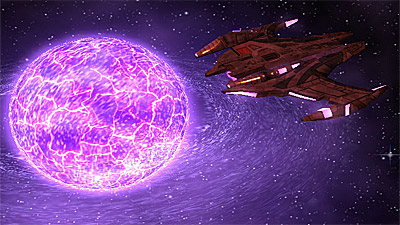
The mixture of real-time strategy and turn-based gameplay is a fun combination, but it’s not quite enough to offset the overall lack of content. Campaign mode is actually a misnomer. There’s little campaigning to be had; you’ll simply play out a single galactic war until you’ve crushed all of the other races into dust. Then it’s just a matter of starting over and playing as a different race or with different specifications. There are a few minor differences between the races, but it’s nothing that warrants replaying the same map over and over again. A skirmish mode is the only other gameplay option, and it essentially boils down to a single arcade battle which will last a few minutes. Multiplayer options could have greatly extended the game’s limited entertainment value, but none are present.
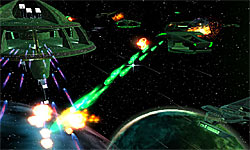
On the visual front, Conquest is rather disappointing. Most of the game features 2D sprites with little to no animation. The galaxy map is equally uninteresting. At the most, some of the small ships may be visually pleasing in a nostalgic way for anyone who’s grown fond of the Star Trek series. The arcade mode visuals are an improvement over the rest of the game, but the awkwardly close camera angle makes it tough to keep up with the faster enemy ships. A few brief cut scenes simply depicting fleets of war ships approaching the battle serve as transitions. Much of the audio is forgettable except for the unintentionally funny voice-over battle calls which are repetitive.
The only discernable difference between the two console versions of the game is use of the Wii Remote and Nunchuk instead of the PS2 controller. The Wii controls work well, but not enough to justify having to pay $30 for the Wii version versus $15 for the PS2 version. It’s a bizarre anomaly. For only a mere $15, much of the gripes regarding Conquest begin to melt away, making the PS2 version superior in that regard.
It would not have taken much effort to make the minor improvements necessary to elevate Conquest from a mediocre title to something worthy of the Star Trek brand. The presence of a true campaign mode containing even a minor overarching plot would improve the play experience significantly, and adding in some favorite main characters from the series (instead of a slew of secondary chumps for admirals) might appease the Trekkie crowd. The limited gameplay itself is solid enough to warrant a few hours of space combat, but as a Star Trek title, Conquest simply doesn’t live up to expectation.
RATING OUT OF 5 RATING DESCRIPTION 2.9 Graphics
Lots of 2D sprites and drab galactic backgrounds…meh. 3.5 Control
The controls work well. 2.5 Music / Sound FX / Voice Acting
Voice-overs are bad in a funny way, and the rest is just background. 3.0 Play Value
It’s surprisingly fun for an hour or two, but the lack of features is atrocious. 3.1 Overall Rating – Fair
Not an average. See Rating legend above for a final score breakdown.
Game Features:
